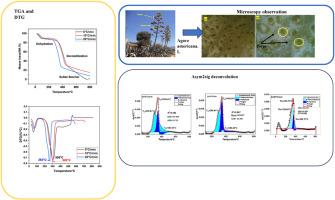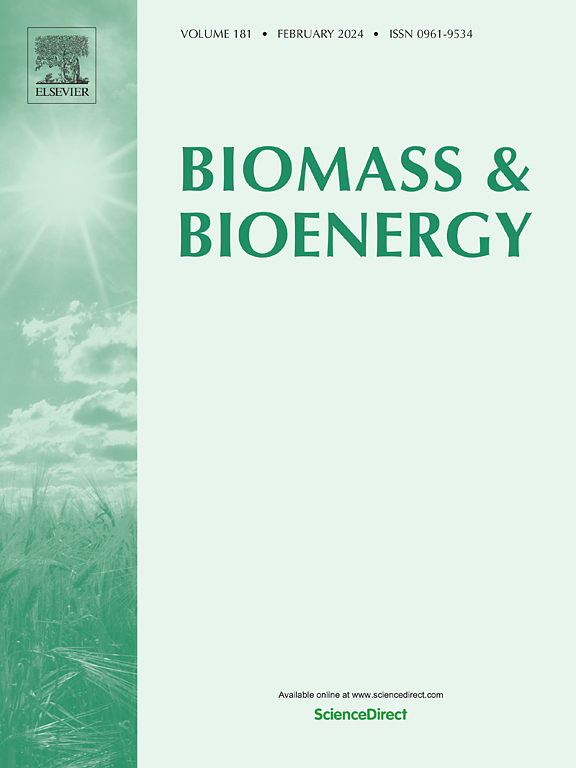Studying Gaussian deconvolution and multicomponent kinetics models in Agave cellulosic fibers pyrolysis: Application in sustainable bioenergy for cleaner production
IF 5.8
2区 生物学
Q1 AGRICULTURAL ENGINEERING
引用次数: 0
Abstract
This study investigates the behavior of heat and pyrolytic kinetics of flower stalks of Agave americana (FSAA) fibers, focusing on their potential for bioenergy production through pyrolytic conversion. Thermogravimetric analysis reveals distinct stages of thermal degradation influenced by varying heating rates (β), demonstrating accelerated volatilization and altered decomposition temperatures with increased β. Deconvolution kinetic analysis using Gaussian functions delineates unique decomposition ranges for pseudo hemicellulose, cellulose, and lignin within FSAA, offering insights into their thermal stability and decomposition pathways. Kinetic parameters derived from multiple models highlight significant differences in activation energies and reaction frequencies across biomass components, underscoring the complexity of their thermal decomposition kinetics. Thermodynamic analysis elucidates varying energy requirements and spontaneity in decomposition processes, which is crucial for optimizing bioenergy yield. Results indicate that higher β leads to enhanced pyrolysis efficiency, with peak temperatures for maximum weight loss shifting significantly upwards. Specifically, activation energies for pseudo hemicellulose range from 22.269 to 116.089 kJ/mol, while those for cellulose and lignin vary from 72.070 to 101.916 kJ/mol and 68.678–105.031 kJ/mol, respectively. This comprehensive analysis contributes novel insights into optimizing pyrolysis processes for FSAA fibers, advancing their application in sustainable bioenergy technologies.

研究龙舌兰纤维素纤维热解中的高斯解卷积和多组分动力学模型:可持续生物能源在清洁生产中的应用
本研究调查了龙舌兰花茎(FSAA)纤维的受热行为和热解动力学,重点研究其通过热解转化生产生物能源的潜力。热重分析揭示了受不同加热速率(β)影响的不同热降解阶段,表明随着 β 的增加,挥发速度加快,分解温度改变。从多个模型中得出的动力学参数突显了不同生物质成分在活化能和反应频率上的显著差异,突出了其热分解动力学的复杂性。热力学分析阐明了分解过程中不同的能量需求和自发性,这对优化生物能源产量至关重要。结果表明,β 越高,热解效率越高,最大失重的峰值温度显著上移。具体来说,假半纤维素的活化能在 22.269 至 116.089 kJ/mol 之间,而纤维素和木质素的活化能分别在 72.070 至 101.916 kJ/mol 和 68.678 至 105.031 kJ/mol 之间。这项综合分析为优化 FSAA 纤维的热解过程提供了新的见解,推动了它们在可持续生物能源技术中的应用。
本文章由计算机程序翻译,如有差异,请以英文原文为准。
求助全文
约1分钟内获得全文
求助全文
来源期刊

Biomass & Bioenergy
工程技术-能源与燃料
CiteScore
11.50
自引率
3.30%
发文量
258
审稿时长
60 days
期刊介绍:
Biomass & Bioenergy is an international journal publishing original research papers and short communications, review articles and case studies on biological resources, chemical and biological processes, and biomass products for new renewable sources of energy and materials.
The scope of the journal extends to the environmental, management and economic aspects of biomass and bioenergy.
Key areas covered by the journal:
• Biomass: sources, energy crop production processes, genetic improvements, composition. Please note that research on these biomass subjects must be linked directly to bioenergy generation.
• Biological Residues: residues/rests from agricultural production, forestry and plantations (palm, sugar etc), processing industries, and municipal sources (MSW). Papers on the use of biomass residues through innovative processes/technological novelty and/or consideration of feedstock/system sustainability (or unsustainability) are welcomed. However waste treatment processes and pollution control or mitigation which are only tangentially related to bioenergy are not in the scope of the journal, as they are more suited to publications in the environmental arena. Papers that describe conventional waste streams (ie well described in existing literature) that do not empirically address ''new'' added value from the process are not suitable for submission to the journal.
• Bioenergy Processes: fermentations, thermochemical conversions, liquid and gaseous fuels, and petrochemical substitutes
• Bioenergy Utilization: direct combustion, gasification, electricity production, chemical processes, and by-product remediation
• Biomass and the Environment: carbon cycle, the net energy efficiency of bioenergy systems, assessment of sustainability, and biodiversity issues.
 求助内容:
求助内容: 应助结果提醒方式:
应助结果提醒方式:


